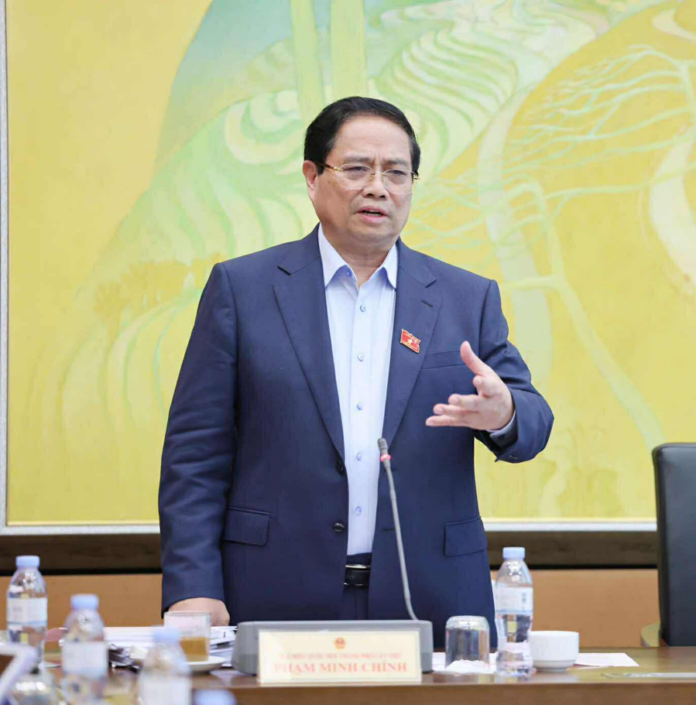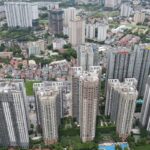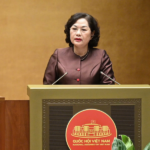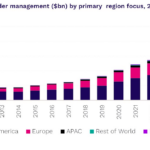On the morning of May 23, the National Assembly discussed several issues, including an additional assessment of the implementation of the socio-economic development plan, the state budget for 2024, and the implementation of the socio-economic development plan in the first months of 2025, as well as practices of economization and anti-wastefulness.
Regarding the solutions for the growth target, the head of the government stated that in the current challenging global context, financial institutions forecast lower growth this year compared to last year and the beginning of the year. However, Vietnam goes against the global trend by raising the growth target to 8% in 2025 and maintaining double-digit growth in the following years. So, what will Vietnam do to achieve this goal?
THE STRATEGIC QUARTET AND THREE BREAKTHROUGHS TO BOOST RAPID AND SUSTAINABLE ECONOMIC DEVELOPMENT
Raising the issue, the Prime Minister pointed out three strategic breakthroughs that Vietnam is actively implementing: removing institutional bottlenecks, promoting infrastructure development, and improving human resources.
First, institutions are both a resource and a driving force for development, so removing bottlenecks and turning institutions into advantages to enhance competitiveness is essential. This is a crucial solution to contribute to promoting, removing obstacles, and creating a driving force and resources for development.
Second, there must be a focus on the strategic breakthrough in infrastructure development. The Prime Minister emphasized that this is a bottleneck, as the high logistics cost of about 17-18% is higher than the global average of 10-11%. This reduces the competitiveness of goods in the market. Therefore, it is necessary to continue promoting strategic transportation infrastructure in all five modes.
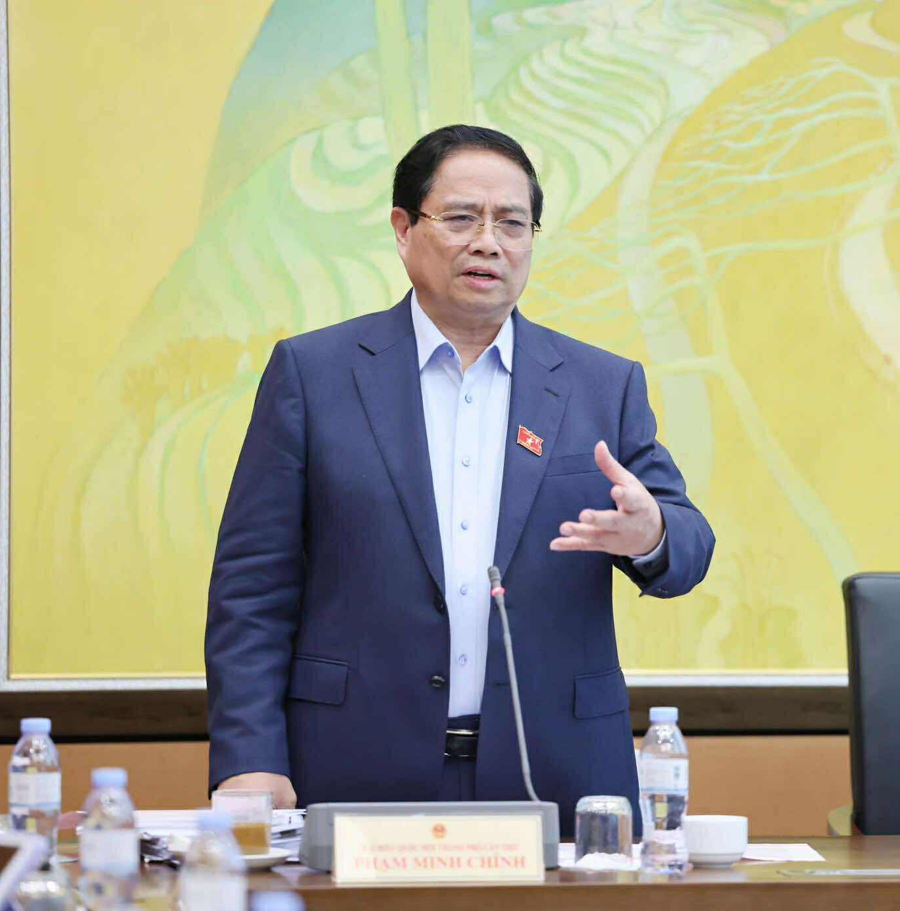
In terms of road infrastructure, Vietnam is promoting the completion of 3,000 km of highways in 2025, along with the development of railway systems. Railways balance air and sea transport as air transport is expensive, and sea transport takes time. On the other hand, railways have a large carrying capacity, are inexpensive, and can operate day and night.
Therefore, it is crucial to upgrade the railway system and construct a high-speed North-South railway and high-speed railways connecting to China, specifically the Lao Cai-Hanoi-Haiphong line, thus opening up connections to China, Central Asia, and Europe…
Regarding inland waterway transport, the Prime Minister emphasized the advantages of the Mekong Delta region. Therefore, this type of transport will be focused on in this and the next year to reduce freight costs and increase competitiveness.
As for air transport, the Prime Minister mentioned that this mode is becoming popular. To develop air transport, large-scale and strategic airports, aircraft fleets, and systems are necessary.
Concerning sea transport, the Prime Minister stressed the importance of constructing large ports that can accommodate the largest ships. With a 3,000-kilometer coastline, Vietnam needs to develop its seaports and maritime transport. Several ports are being prioritized for development, such as Lach Huyen, Cai Mep-Thi Vai, Can Gio, and Hon Khoai, to promote maritime transport.
In addition, infrastructure in education, healthcare, culture, society, and sports must be comprehensively developed.
Third, the head of the government also emphasized the breakthrough in human resources training. Labor productivity depends on multiple factors, but people and human resources are of utmost importance.
Along with the three strategic breakthroughs mentioned above, the head of the government also highlighted the recently issued Political Bureau’s Quartet of Strategies, which includes Resolution 57-NQ/TW on the breakthrough in science, technology, innovation, and national digital transformation; Resolution 59-NQ/TW on international integration in the new situation; Resolution 66-NQ/TW on innovating the work of building and enforcing laws to meet the country’s development demands in the new era; and Resolution 68-NQ/TW on developing the private economy. Implementing this Quartet of Strategies will promote rapid and sustainable economic growth.
RENOVATING TRADITIONAL GROWTH DRIVERS
The Prime Minister also emphasized that Vietnam must actively, proactively, and effectively integrate, keeping up with the times and “advancing together, catching up, and surpassing.” It is essential to proactively upgrade the country’s brand.
To successfully achieve the growth and development targets, it is necessary to renovate traditional growth drivers such as investment, exports, and consumption. Regarding investment, state investment should lead and catalyze all social investment and mobilize social resources for development. This is a traditional driver that needs to be renewed, and it is essential to promote domestic investment, direct investment, indirect investment, FDI, and private investment.
Regarding the export growth driver, which is currently facing challenges due to the tax policies of the United States, the Prime Minister emphasized the importance of staying calm and diversifying markets, products, and supply chains while disengaging from the current context.
It is also crucial to actively negotiate with the United States, ensuring national interests, engaging in dialogue, listening, and persistently persuading without fear or panic, nor negligence or subjectivity. We must be ready to address the issues of concern to our partners, protecting our core interests in a mutually beneficial spirit.
To successfully achieve the growth and development targets, it is necessary to renovate traditional growth drivers such as investment, exports, and consumption. Along with traditional drivers, it is crucial to deploy and promote new growth drivers such as digital transformation, green transformation, and circular economy.
In terms of consumption, fiscal policies should reduce taxes and fees to lower business costs, and administrative procedures should be minimized. Monetary policies should include debt postponement, rescheduling, restructuring, and reduction of interest rates to facilitate people and businesses, thus expanding production and business activities and promoting consumption.
Along with traditional drivers, it is crucial to deploy and promote new growth drivers such as digital transformation, green transformation, and circular economy.
In challenging conditions, developed countries are lowering their growth targets. To go against the global trend and achieve high growth, we need solutions. “In special circumstances, we must have special solutions and adapt flexibly and effectively to the situation to reverse the trend. We must unite, be determined, make great efforts, and take resolute actions with the motto of thinking deeply, acting largely, looking far ahead, clearly dividing tasks, and specifying responsibilities, products, and timelines,” the Prime Minister emphasized.
Regarding the two-level government, the Prime Minister stated that the most important thing is to shift from a passive state of receiving to actively serving the people and businesses, resolutely cutting administrative procedures and eliminating the “application-approval” mechanism, and clearly defining the division of powers and responsibilities.
The Prime Minister informed that the government is determined to reduce administrative procedures and compliance costs for people and businesses. To achieve this, it is necessary to promote planning, develop standards and norms, and other necessary conditions, and publicly announce the conditions and norms for people to implement.
Instead of prior inspection, the government will carry out post-inspection through inspection, supervision, and risk management. State management will involve strategy formulation, planning, law making, policy development, supervision and inspection, and law enforcement summary.
Regarding decentralization and delegation of power, the Prime Minister stated that we are implementing decentralization and delegation of power along with resource allocation, accompanied by inspection and supervision tools and specific criteria and regulations.
RESOLUTELY DEALING WITH STAGNANT PROJECTS TO RELEASE RESOURCES
On economization and anti-wastefulness, the head of the government informed that the government had recently reported to the National Assembly on stagnant projects that have lasted for many years, even across multiple terms, and wastefulness related to inappropriate policies.
The Prime Minister cited the example of having to resolve a series of wind and solar power projects through Resolution 133 to address bottlenecks. The root cause was the inadequate policies, which led to negative impacts and the rush to construct wind and solar power projects that did not comply with planning and procedures…
According to statistics from localities, there are about 2,200 stagnant projects nationwide. Therefore, if these projects are unblocked, it is possible to release more than $230 billion, equivalent to 50% of GDP.
The Prime Minister stated that to release resources from stagnant projects, the government is developing mechanisms and policies to submit to competent authorities for approval.
The head of the government affirmed that there is no intention to legalize wrongdoings, but it is necessary to find solutions, such as institutional, organizational, legal, and implementation solutions. Dealing with stagnant projects is mandatory and unavoidable. These are “diseases” of the economy, and to treat and resolve them fundamentally, we must accept certain losses.
In the process of handling these stagnant projects, we will draw lessons and improve mechanisms and policies to avoid similar mistakes in the future. The Prime Minister emphasized, “Resolutely dealing with stagnant projects is inevitable. We must accept certain losses, considering them as ‘tuition fees,’ and then formulate mechanisms and policies to resolve them fundamentally.”
“Billions Pour into Real Estate, but Companies Still Starve for Capital: Unveiling the Capital Conundrum”
As of the end of March, real estate business credit balances had surged by 20% compared to the end of 2024. This growth aligns with the recovering real estate market trend. However, it is crucial to carefully manage and direct capital flows into segments that align with the purchasing power of the population to mitigate risks.
Crafting Vietnam’s Global Financial Destiny: The Significance of a Dual-Hub Paradigm
Vietnam’s dynamic financial landscape is evolving, and a multi-hub system is the key to unlocking its potential. We propose a visionary strategy to establish Da Nang as an innovative testbed and a green finance powerhouse, working in harmony with Ho Chi Minh City’s established financial prowess. This strategic move will create a robust and sustainable financial ecosystem, harnessing the strengths of both cities.
Governor Nguyen Thi Hong: The Bad Debt of the Credit System is Currently High and on the Rise, Posing Significant Challenges for the Banking Sector
The governor emphasized the urgency of providing liquidity support to commercial banks through special lending facilities to ensure the safety and security of the credit system. Synchronizing the legal framework for dealing with non-performing loans will facilitate capital rotation and enhance credit accessibility for citizens and businesses alike.
The Ultimate Oceanfront Metropolis: SmartRealtors Proudly Presents Blanca City
On May 20, 2025, in Ho Chi Minh City, Vietnam, SmartRealtors & Partners, a leading real estate company, was officially appointed as the exclusive distributor for the prestigious Blanca City seaside metropolis project. This announcement was made at the project’s kickoff event, hosted at the prestigious GEM Center in District 1. Sun Property, a prominent member of the renowned Sun Group, is the visionary developer behind this transformative urban project.
“Vietnamese Businesses Seek Alternative Funding Through Private Lending”
According to statistics from Beacon Fund, the number of businesses seeking capital from Beacon nearly tripled in the latter half of 2024 compared to the same period the previous year.

